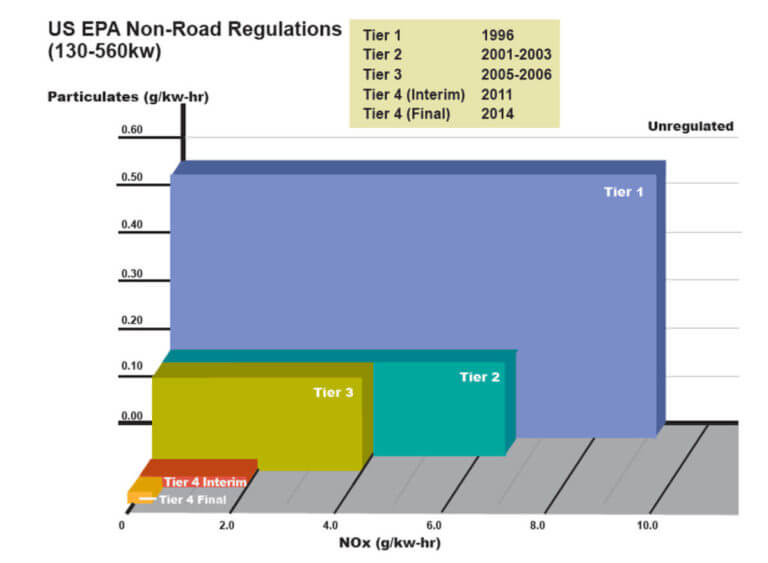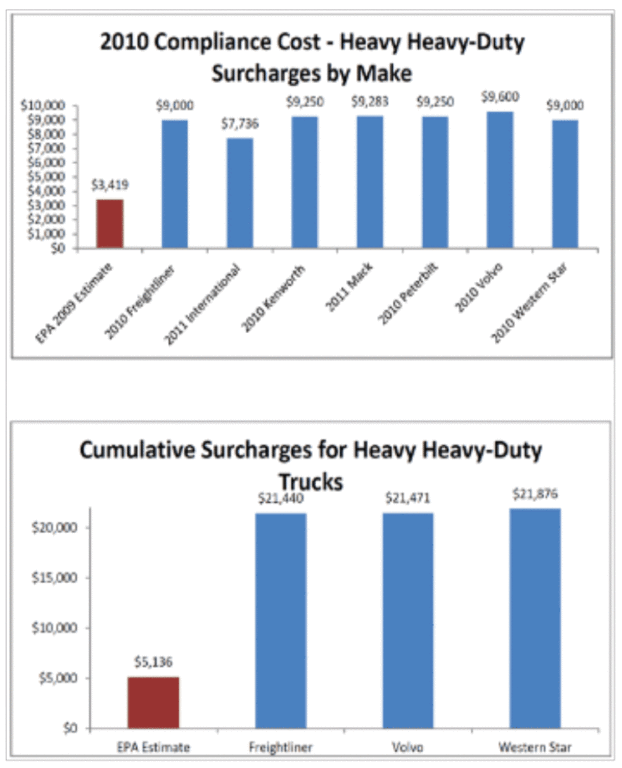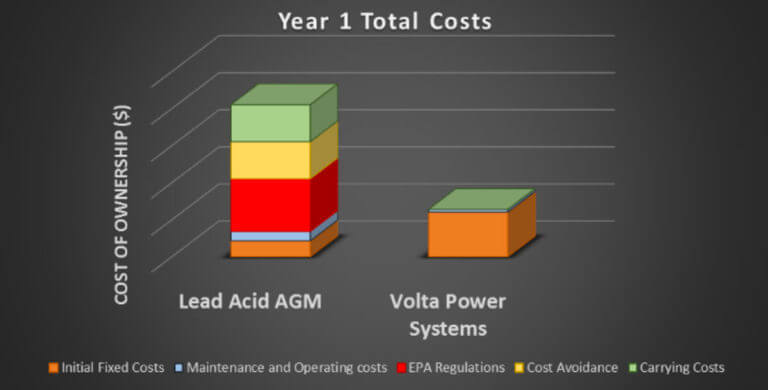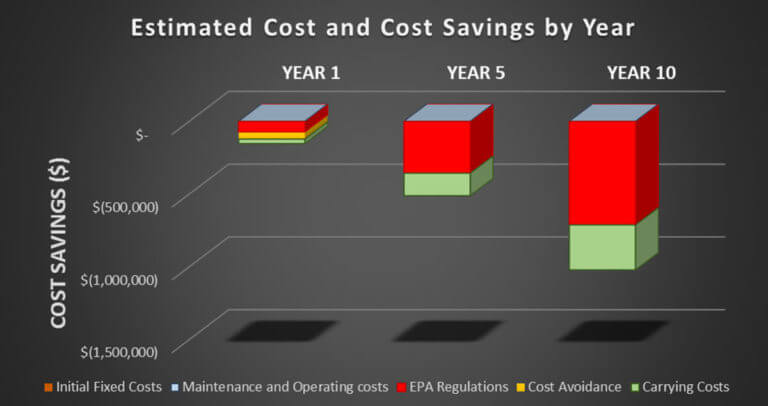EPA Regulations
Highlights of EPA Regulations
Are you aware of what Tier 4 regulations mean to you and your future products?
In most cases fuel consumption increases, power output decreases, the system size is larger, and historically the maintenance time increases – as high as 29%!
Volta’s energy system can help you solve these issues, increase the performance and satisfaction for your customers – with a payback!
What are the regulations?
Get an overview of the regulations from the EPA Website: www.epa.gov

The Environmental Protection Agency set forth new rules in 1997, 2000, and 2001 which dictate emission standards for light, med and heavy duty trucks. These regulations have been phased in over the years with different tier levels of increasing compliance targets for emissions.
State and Local environmental authorities have also set limits on emissions.
Special Local Regulations
Along with California, some regions and localities have stationary emission limits far more stringent than EPA diesel engine tier levels. These include non-attainment areas in the United States such as Southern California; the New England states; Atlanta, Georgia; and Houston, Texas. The result is that diesel-fueled generator sets deployed in these areas, even if certified to the appropriate EPA tier level, may not meet local requirements. As the US EPA lowers NAAQS levels nationwide, more areas will fall into non-attainment status and thus further restrictions on engine emissions will likely be implemented.
More State and Local Requirements
„More than any point in the past, the number of state and local laws regulating the use of diesel engines and equipment are growing. This constantly changing environment requires that equipment owners and dealers stay abreast of state and local laws and regulations which can regulate emissions, idling times and fuel use.“ Association of Equipment Manufacturers
Are You Ready for Tier Four?
Generator manufacturers are slowly catching up to the Tier 4 standard offering new compliant products. Expect to pay an additional 8-20% for a generator for compliance.
„Tier 4 is the law of the land. It is no longer avoidable if you want to purchase new equipment.“
The latest round of regulations
„Tier 4 refers to a set of emissions requirements established by the EPA to reduce emissions of particulate matter (PM), oxides of nitrogen (NOx) and air toxics from new, non-road diesel engines. As part of this clean air initiative, the EPA proposed New Source Performance Standards (NSPS) to define the acceptable levels of emissions in large stationary generator sets. Standards set forth by NSPS are intended to regulate national emissions and are designed to be progressively tightened over time to achieve a steady rate of air quality improvement without unreasonable economic disruption.“ –Institute of Electrical and Electronics Engineers
That’s right – as of 2015 all new generator over 70 hp must have all the same regulatory controls as the rest of the vehicles, which industry wide has reduced fleet efficiency (uptime) by 29%.- NADA
Volta’s solution allows you to have the same performance as before 2015 regulations but with ½ the generator size eliminating the EPA controls by falling below the HP ratings.
Is your generator compliant to Tier 4?
With Volta Power Systems you can reduce your generator size from 21 to the complaint 12kW. Will you lose your power output and ability to run your accessories? No – with Volta Power Systems with a 12kW generator you will be able to get the same power output as you would a 21kW generator. At a certain output the Volta Power Systems will take over and power your needs.
What is the cost to comply?
EPA underestimates cost of compliance!
EPA Regulations

The cost to comply with EPA and CARB emissions requirements is hefty. A recent study by Calpin and Jennings showed that the EPA underestimated the cost for compliance to the MY 2004-2010 by a factor of 2-5. With the 2015 regulation on generators the impact on performance, life, and operational efficiency will be considerably higher than EPA estimates, and will impact customer satisfaction.
EPA Emission standards affect the following:
- Generator use and time
- Fuel use
- Idling times/Downtime
RV dealers caught up in new EPA emissions requirements
„On Jan. 1, the Environmental Protection Agency implemented new standards for installation of onboard generators that matched rules developed by the California Air Resources Board. The new laws require RV manufacturers and dealers to install fuel systems that limit gas vapors emitted from RV generators.
There is no difference as to whether a trailer manufacturer or an RV dealer installs the generator — it must comply with the new rules. “A dealer or any other service center has the same obligations as the OEM to select and install generators and fuel system components the meet the EPA requirements,” a Cummins Onan document noted.
‚A 14-gallon EPA-compliant fuel system will cost approximately $300. However, dealers who fail to install the required tanks will face a fine of $37,500 per incident,‘ Mitchell said.“ – RV Daily Report
What are the EPA’s anti-idling laws?
Anti-Idling
If you stop your vehicle for more than 5-10 minutes you have to turn the engine off or face large fines. The same thing is occurring in campgrounds across the country where you are not allowed to run your generator after sunset due to noise pollution.
Anti-Idling mandates are set at the federal, state and local level. You must keep informed of where you are and how long you can idle. Think twice before you run your gen set or idle your engine or you may be fined.
How Does Volta Power Systems Help?
CO2 Emissions
The Volta Power Energy Storage System allows you to reduce the generator size from 21kW to 12kW. This reduces the CO2 emissions and is EPA compliant. On an annual basis you can reduce your carbon footprint by decreasing the CO2 emissions by over 700 tons or 1.4M lbs of carbon emissions. While we cannot put a price tag on this benefit we have calculated that you would need to plant an additional 3,690 trees to make up for the increased CO2 emissions of just one RV on the road using these accessories.
What about Noise?
Our energy storage system is quiet. Gone are the days of the generator background noise. The National Park Service mandates that any noise must be below 60 decibels at a distance of 50 feet. Most generators run at 60-70 decibels.
National Park Service Regulations
What can downtime cost you?
With Volta Power Systems you can enjoy more power for more time.
Are you leasing an RV for a client’s travel? Do you currently have to make stops to reduce runtime of your generator for EPA compliance? If your lease is $1000/day that equates to $41.60/hour. Using lead acid batteries that require 15-18 hrs of charge time equates to $625 to $748 a day for charging. Volta Power Systems significantly reduces downtime associated with EPA mandates as well as battery charging.
Need an AC unit to run all night? No problem. Depending on the amount of accessories the Volta Power Systems can power your AC unit all night long allowing you peaceful sleep. A lead acid battery system cannot provide you that luxury.
Lead Acid AGM Batteries: Run Time vs Charge Time
[pie_chart2 width=“ height=“ color=’#333333′]33,#81d742,Run Time; 67,#dd3333,Charge Time[/pie_chart2]
Volta Power Systems: Run Time vs Charge Time
[pie_chart2 width=“ height=“ color=’#333333′]67,#81d742,Run Time; 33,#dd3333,Charge Time[/pie_chart2]
(Graphs based on theoretical assumptions. Real results will be based on the demand on the battery.)
Reliable Power
Have you ever suffered from spotty shore power?
Using the Volta Power Energy Storage System you do not have to depend solely on the reliability of shore power. Park where you want, when you want and enjoy running your accessories. No need to worry about brown-outs, reduced shore power or even availability of shore power.
Space and Weight – How big is the Volta Power Systems compared with Lead Acid Batteries?
Space
Using 9 lead acid AGM batteries would have taken up roughly 2.5X the space required in our RV. (9) 8D AGM batteries would have required 12.3 cubic feet of space compared with the 5.1 cubic feet required for the Volta Power Energy Storage System. Also of benefit is the reduced generator size (21 kW to 12 kW) needed for the Volta Power Energy Storage System which saved another 21 cubic feet. For a $1.2M Motorhome the cost of space is high at $2376/cubic foot. The cost to carry a lead acid system would be over $30K based on $/cubic foot.
Weight
The weight of the AGM batteries would have been close to 1458 lbs compared to 350 lbs for the Volta Power Energy Storage System. This weight reduction not only has a fuel savings benefit but also keeps the GVWR weight down which is important for compliance. Think about the weight and space savings that you can utilize for yourself versus previous limitations.
Cost Avoidance
What does Volta Power Systems save YOU?
The Volta Power System eliminates the needs for Bus air and opens up ½ of a full bay allowing you to enjoy more spare, more cargo area or more room for fun. With Volta’s ability to produce enough power to run your roof A/c’s do you need the large fixed bus air option? The elimination of need of the bus air option allows better opportunities for you vehicle and can save you over $35K in investments.
You will also save money by not having an EPA certified technician service your air unit.
What else? Annual maintenance, downtime, etc.
While the cost of the initial investment for the Volta Power Systems Energy System is higher than buying (9) 8D AGM batteries, we did the following calculations to show the cost benefit over time.
Compliance to EPA Regulations
- $3-4K to comply with EPA regulations
- What is the value of downtime? Our studies suggest on a vehicle that is used on a daily lease rate could lose up to $ 67,000 dollars annually in revenue due to maintenance downtime associated with emission controls on the generators.
*Downtime due to the restrictions which would have cost over $67K/year if we include rental for the vehicle at $1000/day
Carrying costs: What is your cargo space worth?
A simple way to look at space is the value of the vehicle and the space currently available. Then take away or add based on size changes. The increase size of the generators and the size of lead acid batteries consume valuable space.
- $30K of lost storage space**
**Additionally using lead acid batteries would have taken up roughly 2.5X the space required in our RV. Using (9) 8D AGM batteries would have required 12.3 cubic feet of space compared with the 5.1 cubic feet required for the Volta Power Energy Storage System. Also of benefit is the reduced generator size (21 kW to 12 kW) needed for the Volta Power Energy Storage System which saved another 21 cubic feet. For a $1.2M Motorhome the cost of space is high at $2376/cubic foot. The cost to carry a lead acid system would be over $30K based on $/cubic foot.
Cost Avoidance: With Volta’s ability to produce enough power to run your roof A/c’s do you need the large fixed bus air option?
The elimination of need of the bus air option allows better opportunities for your vehicle.
- Bus Air – $37K
The Volta Power Energy Storage System has an increased initial investment over the traditional lead acid AGM solution. However, traditional solutions require additional costs due to maintenance, EPA compliance and lost storage space – costs you won’t pay with Volta Power Systems
Over time the added costs for a lead acid AGM solution increase making the Volta Power Energy Storage Solution attractive for the lifetime of the RV.
Using the Volta Power Energy Solution allowed for more reliable power for more comfort and entertainment accessories with more benefits. Over 8000W of accessories were powered for over 6 hours.
During this trip the Volta Power System was able to provide continuous power for over 8000W of accessories for 6 straight hours before charging. Charging the system took 4 hours.
The investment in a Volta Power Energy Solution lowers the cost of ownership over time when compared to using traditional lead acid AGM batteries.
Volta Power Systems offers complete and configurable engineered solutions to meet all of your application needs. Energy storage solutions can be designed with your application in mind taking all of the guesswork out of figuring out what is needed.
For more information, please see:
NADA Report 2010 by Calpin & Jenning
EPA site: epa.gov/oms/hd-hwy.htm

